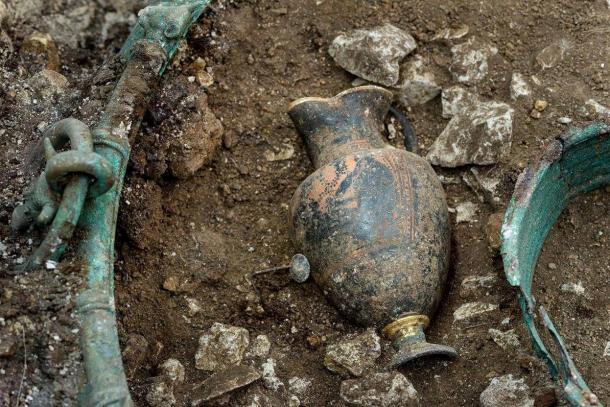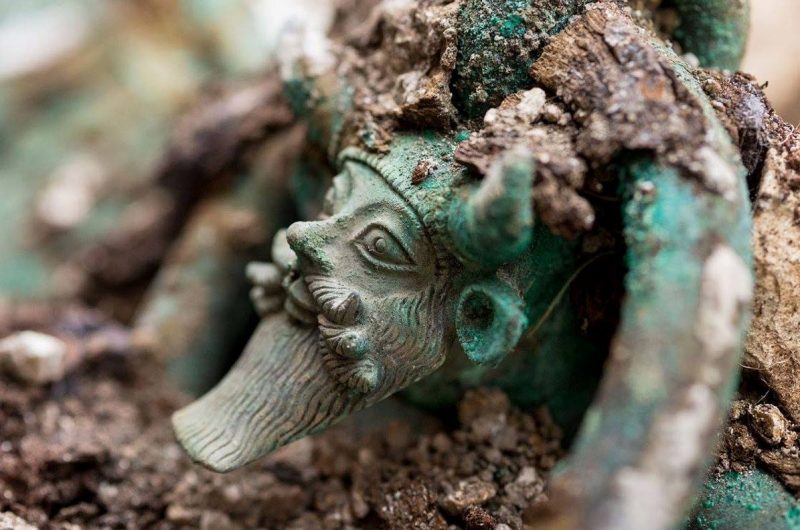There’s a massive funerary chamber in France where Archaeologists are doing a research for what they believe was a 5th century BC Celtic Prince holding his chariot, a bronze made cauldron, a vase with a Greek god of wine and ecstasy painted on it, a huge knife and few other artifacts.
These treasure worth found artifacts in the Champagne region are “fitting for one of the highest elite of the end of the first Iron Age”, according to the French archaeological agency INRAP in the French-English “The Connexion” newspaper.
These Archaeologists, from the French National agency – INRAP, dug 40m (131feet) underground to find these valuables on the edge of a park near Lavau. The tomb is bigger than the cathedral in nearby Troyes, the article reported. It covered nearly 7655sq. yards and was surrounded by a palisade and ditch when found in tumulus (tumulus is a burial mound or barrow).
Their page on Facebook claims that the center of the almost 44-yard diameter tumulus has his chariot “at the heart of a vast funeral chamber” of 15,3 yards squared.
Even though they’ve found only some parts of a skeleton, the Archaeologists haven’t still identified the princes’ remains. They only think that they’ve found a body of a princes’ relative among with some funeral urns and other graves, and claim that they’ve already dated some of the ashes in the urns to 1400 BC.
The tomb was found when they were inspecting the ground in order to explore it and prepare it for a new commercial center construction. The president of INRAP, Dominique Garcia, said they were sure the tomb was a princes’ because of the big knife they’ve found in it.

As reported, the Archaeologists consider the most important find was the 1meter-diameter bronze cauldron. Its 4 handles were decorated with Achelous’ head (Achelous is the river god of ancient Greeks). It also had 8 lionesses’ heads, and a ceramic oinochoe wine jug with Dionysus under a grapevine painted in it. They assume that the wine set was a centerpiece of an aristocratic Celtic banquet. As INRAP reported, it is a “Greco-Latin” wine set which confirms that the Celts and folks from the Mediterranean region were making exchanges.
“At the time [of the burial] Mediterranean traders were extending their economic range, seeking slaves and precious metals and jewels. The Celts, who controlled the main communication routes along the Seine, Rhône, Saône, Rhine and Danube, benefited from the exchanges to get prestigious objects,” the Connexion article reported.
Today Celtic peoples are in Brittany, Cornwall, Wales, Scotland, the Isle of Man and Ireland.
The Ultimate Encyclopedia of Mythology says: “At one time, however, the Celts were spread over a large part of the [European] continent, and in 278 BC one roving band even penetrated as far east as Asia Minor, where they gave their name to Galatia. Until the rise of the Roman power, the Celts were a force to be reckoned with. Rome itself had been sacked by them in 385 BC, a historical fact not forgotten by the legionnaires who gave Julius Caesar victory between 59 and 49 BC over the Celtic tribes living in Gaul, present-day France. Although largely incorporated into the Roman Empire, the Celts continued to worship their own gods and goddesses right up to the time of the official adoption by the Romans of the Christian faith.”

Cuchulainn of Ireland was one of the most important Celtic heroes. Died at an early age he was slain in a heroic defense of Ulster.
Dagda (means “the good god”) was the chief Celtic God of the Irish, apparently, was very wise, knowledgeable and a great magician. As it is known, Dagda could slay his enemies with one end of his club and heal and resurrect his allies with the other. An inexhaustible bounty could’ve been served up by his magical cauldron.
During a truce before the second battle of Magh Tuireadh, Dagda visited the enemies camp – Fomorii. As the Fomorii required, he was supposed to eat a porridge of flour, fat, milk, pigs and goats, that all together could’ve fed up to 50 men, or instead, they would’ve kill him.
“This test turned Dagda temporarily into a gross old man, but it did not prevent him from making love to a Fomorii girl, who promised to use her magic on behalf of the Tuatha De Danann. The story may recall, in a distorted form, a holy marriage between a chieftain and a maiden at the beginning of each year; similar to the sacred rite that was performed by a Sumerian ruler and a priestess in Mesopotamia. This union was meant to ensure prosperity, strength and peace.”

